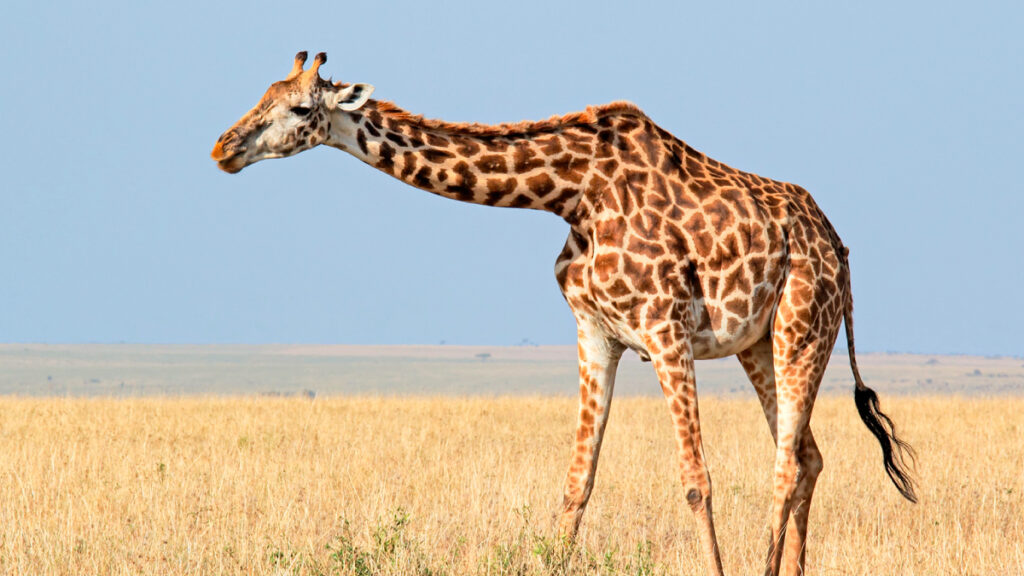Discover the fascinating world of the Masai giraffe, a unique and striking creature known for its incredible height and gentle demeanour.
| Classification | Name |
|---|---|
| Scientific Name | Giraffa camelopardalis tippelskirchi |
| Kingdom | Animalia |
| Phylum | Chordata |
| Class | Mammalia |
| Order | Artiodactyla |
| Family | Giraffidae |
| Genus | Giraffa |
| Species | G. camelopardalis |
| Subspecies | G. c. tippelskirchi |
Table of Contents
Physical Characteristics
The Masai giraffe is an iconic symbol of the African wilderness, characterised by its long neck and distinct coat patterns. Its mosaic-like patches are uniquely irregular compared to other giraffe subspecies.
Physical Characteristics
Length:They typically measure about 4.5 to 5.5 meters in length, with some reaching lengths of up to 6 meters.
Weight: On average, they weigh between 1,000 and 1,900 kilograms. The largest recorded Masai giraffe weighed around 2,000 kilograms.
Largest size found: The tallest Masai giraffes can reach up to 6 meters in height.
Smallest size found: The shortest adult Masai giraffes are around 4.5 meters in height.
Body and Coloration:
The Masai giraffe boasts a distinctive and irregular patterned coat with brown patches separated by creamy tan lines. Its elongated neck contains the same number of vertebrae as most mammals, though they are much larger in size, allowing for its remarkable height. They possess long, sturdy legs that end in cloven hooves, aiding in their mobility across vast savannahs.
Distribution:
Masai giraffes are primarily found in Tanzania and southern Kenya. They inhabit various regions from open plains to savannas, as well as woodland environments.
Habitat and Behaviour
Habitat:
Masai giraffes dwell in diverse habitats ranging from open grasslands to dense savannahs and acacia woodlands. They thrive in areas rich with their preferred food sources, mainly acacia leaves.
Diet:
As herbivores, their diet consists predominantly of leaves, flowers, fruits, and twigs from acacia trees and other plant species. Their long necks allow them to reach high branches that are inaccessible to other herbivores.
Behaviour:
Masai giraffes are known for their gentle and relatively solitary nature. They often form loose herds based on social bonds rather than strict memberships. Communication involves a mix of visual signals, body language, and occasional low-frequency sounds inaudible to humans.
Lifespan:
In the wild, Masai giraffes typically live between 20 to 25 years, although some individuals have been known to live longer under protection from predators and human threats.
Reproduction and Life Cycle:
Mating can occur year-round, and after a gestation period of about 15 months, females give birth to a single calf. Calves are born precocial, meaning they can stand and walk within a few hours of birth. They remain dependent on their mother’s milk before transitioning to solid food.
Predators:
Lions and hyenas are the primary predators of Masai giraffes, particularly targeting vulnerable calves. Adult giraffes are less frequently preyed upon due to their size and powerful kicks.
Adaptations:
Their long necks and legs give them a competitive advantage in reaching high foliage. Additionally, their keen eyesight allows them to detect predators from a considerable distance. The unique coat pattern provides some camouflage among the trees and bushes.
Relationship with Humans:
While generally wary of humans, Masai giraffes are vital for ecotourism. Their presence attracts wildlife enthusiasts and photographers, contributing significantly to local economies.
Conservation Status
According to the IUCN Red List, Masai giraffes are listed as Endangered due to ongoing threats from habitat loss and poaching.
Threats:
Major threats include habitat destruction from agricultural expansion, illegal hunting for bushmeat, and climate change affecting their food sources.
Conservation Efforts:
Efforts to protect Masai giraffes include establishing protected areas, anti-poaching patrols, and community-based conservation programs aimed at promoting sustainable coexistence.
Masai giraffes have an 18-inch long prehensile tongue, aiding them in grasping and stripping leaves from branches.
Despite their height, they are adept runners, capable of speeds up to 35 miles per hour.
Cultural Significance:
In various African cultures, giraffes often symbolize grace and farsightedness. They appear in folklore and traditional art, representing nobility and peacefulness.
Economic Importance:
The Masai giraffe plays a crucial role in maintaining the balance of the savannah ecosystem by helping control vegetation growth. They attract eco-tourists and contribute to conservation funding.
Threats and Conservation Efforts:
Specific threats like habitat fragmentation and climate change necessitate targeted conservation measures. Ongoing efforts include habitat restoration, education, and policies aimed at reducing human-wildlife conflicts.
More Information on Masai Giraffe
What is the average height of a Masai giraffe?
The average height of a Masai giraffe ranges from 4.5 to 5.5 meters, with some individuals growing as tall as 6 meters.
Are Masai giraffes endangered?
Yes, the Masai giraffe is currently listed as Endangered on the IUCN Red List, primarily due to habitat loss and poaching.
What do Masai giraffes eat?
Masai giraffes primarily feed on leaves, fruits, flowers, and shrubs, with a particular preference for acacia plants.
How long do Masai giraffes live in the wild?
In the wild, Masai giraffes have a lifespan of approximately 20 to 25 years, though some can live longer under protected conditions.

